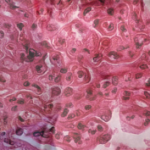 Corticosteroids still represent the mainstay of treatment of patients with active disease. They have been used for more than 60 years, and although prolonged use is associated with organ damage, they have been shown to be lifesaving in various phases of the history of the disease.
Corticosteroids still represent the mainstay of treatment of patients with active disease. They have been used for more than 60 years, and although prolonged use is associated with organ damage, they have been shown to be lifesaving in various phases of the history of the disease.
History of Use
First introduced in the late 1960s in renal transplantation, high-dose intravenous therapy was shown to be safe and effective in increasing graft survival in patients treated with one to three grams of intravenous methylprednisolone.1,2
In 1974, I remember that Edgar Cathcart, one of my mentors, and I were talking with two nephrologists in the cafeteria of Boston University Hospital about their results with pulse therapy in allograft rejection, and the idea came up to try to abrogate acute deterioration of renal function in lupus patients with pulse therapy. The initial results in the first seven patients were published in January 1976.3
As one of the authors of the original paper, I review here the events that surrounded the use of this therapy, as published in The Lancet 40 years ago (see Figure 1, below). We found that in five of seven SLE patients with biopsy-proved diffuse proliferative glomerulonephritis, a marked improvement of renal function was found after three days of 1.0 g pulse of intravenous of methylprednisolone (see Figure 2, below).
Figure 1: The First Paper on Systemic Lupus Erythematosus Nephritis Published
Cathcart ES, Scheinberg MA, Idelson BA, Couser WG. Beneficial effects of methylprednisolone ‘pulse’ therapy in diffuse proliferative lupus nephritis. Lancet. 1976 Jan 24;307(7952):163–166.
Abstract: Seven patients with diffuse proliferative lupus nephritis were subjected to high-dose intravenous methylprednisolone (pulse) therapy. Following the pulse, five patients with rapidly deteriorating renal function improved within three days and their serum-creatinine levels returned to baseline by one month. All seven patients demonstrated reversal of severe immunological abnormalities including increased serum D.N.A. binding, decreased serum C3 levels, and reduced number of T lymphocytes in the peripheral blood. This form of therapy may make it possible to maintain patients with lupus nephritis on lower doses of steroids than is normally feasible.
Since the publication of the original paper in 1976, bolus injections of steroids have seen considerable variation in the dose, number, timing and duration of higher doses. Despite 40 years of use, the clarity of the mechanism of action is still, to some extent, unknown. It is well known that pulse therapy is cumulatively less toxic than treatment with continuous oral steroids at lower doses. However, it is also known that pulse therapy may be associated with side effects, and is contraindicated in systemic infections and uncontrolled hypertension. Its use can lead to metabolic disturbances and changes in behavior, requiring adequate monitoring during its use.
